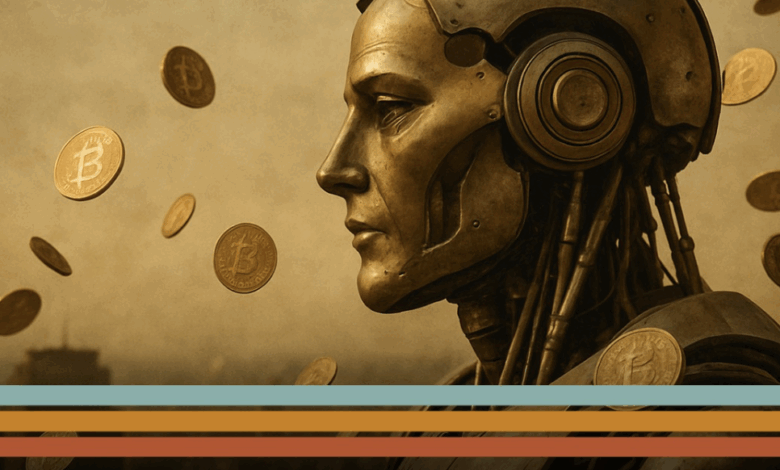
Artificial intelligence is turning software into a decision-maker. Bitcoin is turning the Internet into an economic network. Separately, each technology is revolutionary. Together, they create the foundation for an always-on economy where algorithms can own assets, settle invoices, and reward talent as easily as they crunch data.
1. Scarcity Meets Abundance
AI’s mission is to drive marginal costs toward zero. When algorithms automate research, logistics, and even creative tasks, the price of those services plummets; that deflation can leave fiat currencies and traditional assets looking shaky. Central banks often offset falling prices by expanding the money supply, which can create inflation.
Bitcoin acts as a counterweight: its 21 million coin limit is fixed in code, providing a store of value immune to human policy swings. In an era of hyper-efficient production and potential currency dilution, holding an asset with mathematically guaranteed scarcity becomes a strategic hedge for corporate treasuries and long-term savers alike.
2. Machines Need Permissionless Money
Your AI assistant may soon negotiate contracts, subscribe to APIs, or purchase training data. Yet it can’t walk into a bank branch or pass a “know your customer” check.
Bitcoin fixes that hurdle with self-custodied wallets. A few lines of code generate a private key; from there, an AI agent can receive, hold, and send value worldwide—no gatekeepers, no office hours. This neutrality is critical: algorithms don’t possess passports or credit histories, but they can sign digital transactions. Bitcoin’s protocol validates the math, not the identity.
3. Bitcoin’s Lightning Network Upgrade Unlocks Micropayments
On-chain Bitcoin settlement is secure, but it is slow. The Lightning Network is an innovation in Bitcoin that overlays a second layer where payments clear in milliseconds for fractions of a cent. That’s tailor-made for machine-to-machine commerce: a sensor paying per kilobyte of satellite bandwidth, a microservice charging per database query, or a large language model renting GPU time by the second.
Traditional payment rails—such as credit cards, ACH, and SWIFT—were never designed for millions of tiny transactions per hour. Lightning already is. As infrastructure providers like Lightspark and Breez roll out enterprise-grade toolkits, AI developers gain a plug-and-play payment rail that scales with their computational needs.
4. Programmable Guardrails & Auditability
Bitcoin’s scripting language and multi-signature architecture enable companies to embed spending rules directly into their transactions, allowing for more secure and efficient transactions.
You can think of a set of keys, each one needed to unlock the door to spend, creating intriguing possibilities for AIs to operate under human supervision. Imagine an autonomous procurement bot capped at 0.05 BTC per day and requiring a human cosignature for any transactions exceeding that threshold.
Transactions are immutable and public, allowing auditors to replay every step of the process. Pair that transparency with AI-driven anomaly detection, and suspicious activity flags itself in real time—before funds leave the wallet. The result is a system where governance doesn’t rely on post hoc paperwork; it’s embedded in the transaction layer.
5. One Currency, Global Talent
AI dissolves geographic barriers to expertise. The best engineer for your next project might be in Nairobi or Manila. Paying them via legacy banking means FX spreads, wire fees, and multiday settlement lags. Paying in Bitcoin is one hop: open a Lightning channel and the funds arrive in seconds, 24/7.
For HR teams, that reduces onboarding friction and widens the hiring aperture. For finance teams, it trims currency risk. Over time, as more goods and labor are priced directly in satoshis, Bitcoin could evolve into a unit of account—a common yardstick that intelligent systems use to value work.
The stateless nature of Bitcoin also allows AI to easily pierce through borders and systems without worrying about having a bank account here or there.
6. Energy, Incentives, and Security
Bitcoin’s proof-of-work model often sparks debate, but it offers a property that AI systems will rely on: unforgeable costliness. Every block represents real-world energy converted into network security. That expenditure anchors Bitcoin’s ledger in physics, not promises.
As AI grows adept at forging texts, images, and even videos, anchoring financial truth in something expensive to fake becomes invaluable.
The proof-of-work chain is effectively a tamper-evident audit trail for global value, resistant to the synthetic realities that generative models can create.
By recording when documents were made in Bitcoin’s blockchain, authenticity for that version can be guaranteed by the energy powering Bitcoin’s security. Social keys tied to Bitcoin wallets or charging people small amounts of Bitcoin to do an action can help prevent fraud and spam.
Bitcoin and AI will work together – and AI will use Bitcoin as a native currency, able to easily pass through borders and APIs and with permission levels set at a human level that allow AI agents the freedom to do important tasks, while offering human supervision. The combination of Bitcoin and AI will unlock new potential for both technologies – and exponential new capabilities for humans who master the bridge between both.





